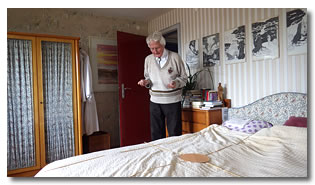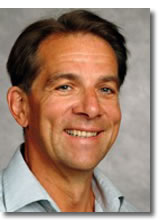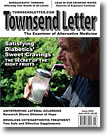|
Over the course of the many decades in which I, as a naturopathically oriented physician, treated chronically ill patients, energetic testing has in hundreds of cases revealed geopathic burdens, more colloquially known as "georadiation" – an as yet not clearly objectifiable physical anomaly in local radiations fields, including the earth's magnetic field. With long-term exposure, geopathies are potentially dangerous and, in my experience – as well as that of numerous colleagues such as the biological oncologist Josef Issels or the biological dentist and physician Helmut W. Schimmel – can do lasting damage to biological systems.1,2 Many chronically ill patients are subjected to geopathic stresses; once these are eliminated, the therapist has eliminated an important obstacle to healing.
Detecting Georadiation
The typical symptoms of geopathy – such as sleep disorders, exhaustion, pain states, tension, nightmares, bruxism, and the like – might not always be present, but they are so ambiguous anyhow that one has to rely on energetic test procedures in order to arrive at a diagnosis. When the patient is stressed by georadiation, test ampoules with similar vibrational patterns will respond for every third to fourth patient. In such cases, I used to use Silicea D60 (Vega test method), but now, with Psychosomatic Energetics (PSE), I use the test ampoule Geovita, a homeopathic compound agent that has proved quite reliable. When checking out a home's bed location with experienced dowsers, there is nearly total agreement with my tentative diagnosis based on test results.
If, based on my tests and the anamnesis, I as a physician suspect geopathy, I recommend that the patient have a reliable and experienced dowser examine the bed site in the home and then seek out a neutral location to sleep at in the future. After examining the sleeping location, a good dowser can determine a maximum zone on the patient's bed with a high degree of accuracy – one that agrees with the patient's symptoms and ailments. Thus, in the case of a brain tumor, a good dowser will determine the most harmful georadiation zone to be in the head region or, in the case of prostate carcinoma, the pelvic region.
On principle, I tell patients not to tell the dowser anything in advance about their illness, and not leave any revealing utensils, doctor's letters, self-help guides, and the like lying around. In my experience, the accuracy of good experienced dowsers is very nearly 100%. Out of several hundred cases, I have seen a good half-dozen of them hit the bull's-eye every single time when determining the maximum zone. I have tried to demonstrate this often-repeated surprising experience (both for me and my patients) statistically in a small pilot study, which I'd like to present below. It goes without saying that the study is not intended merely to display the outstanding abilities of certain dowsers – which is in itself remarkable – but rather also to point out the unclear (yet evidently extremely important) role that geopathy plays in the pathogenesis of many chronic diseases.
Study Design and Results
In the spring 2013 issue of the dowser trade journal Wetter-Boden-Mensch (Weather-Soil-Man), I published a call for participation in a study looking into whether maximum zones of severe chronic diseases such as unambiguously localizable cancers could be determined by dowsers examining the patient's bed site; for example, a zone in the chest region for breast cancer cases. If there is agreement – that is, between geopathic maximum zone and corresponding disease segment – then the dowser has done a good job. I have marked out five areas in which the dowser, after examining the bed location, should make a cross in the corresponding geopathic maximum zone: head, neck, chest, upper abdomen, pelvis.
It is of course a precondition of the study that the dowser know nothing about the disease before establishing the maximum zone. I have had this lack of foreknowledge confirmed in writing with each dowser's notarized signature. In addition, I have asked the dowsers' clients for a photocopy of a current doctor's letter or hospital discharge report, in order to pin down the maximum zone from the medical side, which I have likewise assigned to one of the five body segments.
If one of the five segments were to be checked at random, then there would be a 20% probability of checking the "right" segment. As a physician, I determine "right" when, for example, in a case of meningioma, I determine the head to be the affected and thus only important segment that can be geopathically stressed.
 Now, a year later, I have 13 findings from two dowsers, 12 from Hans Zürn (engineering graduate, Überlingen), considered among experts to be one of the most experienced and best dowsers in Germany, as well as 1 from Dieter Garten of Steina, also an experienced dowser. Plus, for each of the findings I have a corresponding specialist or clinic report at hand, which I compared to assign either "Yes" (agreement) or "No" (disagreement) for each set (Cf. Table 1). Now, a year later, I have 13 findings from two dowsers, 12 from Hans Zürn (engineering graduate, Überlingen), considered among experts to be one of the most experienced and best dowsers in Germany, as well as 1 from Dieter Garten of Steina, also an experienced dowser. Plus, for each of the findings I have a corresponding specialist or clinic report at hand, which I compared to assign either "Yes" (agreement) or "No" (disagreement) for each set (Cf. Table 1).
Table 1: Patient (Numeric Code), Geopathic Maximum (Dowser), Clinical Picture, Agreement (n = 13)
Based on the data, the dowsers' "hit ratio" is 92.3%, if one takes into account the unfortunate (because misleading) result of a systemic neural disease that extended over four segments (amyotrophic lateral sclerosis in one patient). Although, considering the clinical picture, it was impossible to arrive at a definite segment assignment, I have evaluated it along with the rest, even though it detracts from the end result, which would otherwise have been 100%. The 95% confidence interval of the "hit ratio" is (64.0%; 99.8%). This does not include the 20% probability of having identified the correct body segment. Thus, the "hit ratio" of 92.3% is significantly greater than 20%.
What Does This Result Mean?
Skeptics will no doubt suspect that segment localization might have been influenced by very subtle sensory perceptions on the part of the dowser or quite straightforward forms of unintentional knowledge, for instance inadvertent disclosure of the diagnosis by the patients or their relatives. Since I can vouch for the reliability of both dowsers, I do not consider the second counterargument to be valid. And, because I have also experienced comparably accurate results in my decades of clinical experience with highly skeptical patients who did everything they could to make sure that they didn't reveal anything whatsoever to the dowser, I consider the counterargument of hidden foreknowledge to be implausible.
The idea that cancer sufferers might be radiating something ominous into the bed, which the dowser then sniffs out like a bloodhound, as it were, is also highly improbable. Mr. Zürn told me that some patients had moved their beds before his examination without his knowledge, and without its being noticeable through scratch marks on the floor or suchlike. For his bed site examination, Mr. Zürn lays out yardsticks; their points of intersection correspond to the maximum zones. If the shifted bed is then moved back to its original location, then the geopathic maximum zones coincide with the disease in question. This clearly contradicts any theory of some sort of disease emanation that would betray the corresponding stress zone to the dowser.
In my opinion, the study shows that good dowsers can determine the geopathic maximum zones of bed sites with a very high degree of probability, even without knowing anything about the corresponding disease. Even though dowsing is, unfortunately, generally still not taken seriously and considered to be unscientific, my experience as a physician emphatically disagrees: good dowsers achieve impressively accurate results that well in line with reality. Their poor reputation is due to other reasons which I have addressed elsewhere.3
Moreover, since this small pilot study confirms my more than 30 years of experience, as well as that of other therapists, it seems extremely unlikely that the impressive study results can be due to mere chance. But if we are dealing here with real phenomena, what then does the result mean specifically from a medical standpoint? If one finds geopathic maximum zones in the majority of cancer cases, as the results in Table 1 indicate, then it seems pretty safe to conclude that the two are somehow related.
Depending, probably, in the individual case on genetically influenced robustness, geopathic zones can be classified as cocausal factors in many chronic diseases. It would therefore seem to be urgently essential to take a closer scientific look at this important disease source. Until we have some usable results, it seems a good idea to act on one's own. From my viewpoint as a doctor, I recommend an examination by a good dowser in cases involving sleep disorders and other applicable indications. If previous occupants suffered from severe chronic diseases, or possibly died, then the bed should not be placed where the previous owners became ill.
Summary
A small study involving 13 test subjects who had been examined by two dowsers looked into the question of whether georadiation maximum zones could be related to local severe chronic diseases when both of them were independently assigned to one of five body segments (such as georadiation in the pelvic region for prostate cancer cases). One prerequisite is that the dowser know nothing about the corresponding disease in advance, which can be assumed with a high degree of probability, but which should be further investigated in future studies under laboratory conditions.
In 12 of the reports received, geopathic maximum zone and local disease agreed; in one case involving a systemic neural disease, no segmental assignment was possible, so it was classified as nonagreement. Statistically speaking, the results argue against mere chance, since the confidence interval exceeds 95%, so that the result must be considered significant.
It seems plausible – and further studies need to clarify this – that, in the case of numerous severe chronic diseases, georadiation is a cocausal factor. It is quite conceivable that a future double-blind study will have beds of cancer patients and healthy persons prospectively examined by dowsers in order to eliminate any doubt regarding possible dowser foreknowledge. In addition, fundamental research into the physical nature of geopathogenic zones, as well as studies in sleep labs, should definitely be undertaken in order to investigate the hypothesized dependence of dowsers on the location of bed sites.
Evaluation: Dr. Silke Lange, certified statistician, Witten (Ruhr). The study was financed by the Internationale Gesellschaft für Psychosomatische Energetik (International Society for Psychosomatic Energetics), a nonprofit professional association based in Switzerland (www.igpse.ch). Many thanks here to certified engineer Hans Zürn and Dieter Garten for their participation!
Most people think that dowsing is quackery – and unfortunately this is true in many cases. Few dowsers have the ability to find severe geopathic spots matching the location of diseases. I am sure that animals such as the sniffing dogs used at customs could be trained to do the same, as animals are unbiased.
By the way, many people feel the negative effects of geopathic stress, which in my medical experience is the reason for more than 25% to 30% of all sleep problems (childlessness, tumors, behavior problems, etc.). Unfortunately, they are not told to move their beds to another location perhaps a meter or more away, or sleep on a futon in the kitchen, because after a few nights, they would start sleeping better (it takes usually a few nights to adapt to the good spot). This is why people love cruise ships; they are free of geopathic stress (like houseboats). |
Notes
1. Issels J. Mein Kampf gegen den Krebs. [My struggle with cancer]. Bertelsmann Gütersloh; 1981.
2. Schimmel HW. Functional Medicine. Thieme; 1997.
3. Banis R. Erfahrungen über die Zuverlässigkeit energetischer Testmethoden. [Regarding the reliability of energetic testing methods]. Co'med. 2010;11.
 Reimar Banis, MD, ND, has been a naturopath since 1975 and an MD since 1985 (US MD certification through ECFMG, 1984). He conducted research with experts such as Prof. H. Heim in electroacupuncture and Dr. Schimmel, developer of the Vega test, and codeveloped segmentelectrography and thermoregulation; this knowledge, combined with extensive research on energy medicine and energy psychology, led him to create Psychosomatic Energetics (PSE). He first introduced PSE for peer review at a presentation in 1997 at the renowned Baden-Baden Medical Week convention, where he is now an annual presenter. In 1998, he developed the REBA test device with biophysicist Dieter Jossner. He has lectured extensively on PSE worldwide and has developed a comprehensive PSE seminar series, which leads to designation as a Certified Energy Tester. Reimar Banis, MD, ND, has been a naturopath since 1975 and an MD since 1985 (US MD certification through ECFMG, 1984). He conducted research with experts such as Prof. H. Heim in electroacupuncture and Dr. Schimmel, developer of the Vega test, and codeveloped segmentelectrography and thermoregulation; this knowledge, combined with extensive research on energy medicine and energy psychology, led him to create Psychosomatic Energetics (PSE). He first introduced PSE for peer review at a presentation in 1997 at the renowned Baden-Baden Medical Week convention, where he is now an annual presenter. In 1998, he developed the REBA test device with biophysicist Dieter Jossner. He has lectured extensively on PSE worldwide and has developed a comprehensive PSE seminar series, which leads to designation as a Certified Energy Tester.
Dr. Banis has been in general practice since 1985 at his clinic in Saarland (Germany). He has authored over 200 articles on such various topics as adrenal fatigue, fibromyalgia, and the emotional components associated with cancer. He is also the author of 7 books, including Psychosomatic Energetics: A Handbook for Therapists and New Life Through Energy Healing. Trained as a medical doctor, Dr. Banis has the unique ability to bridge the gap between conventional and naturopathic healing methods. He is regarded as one of the most advanced and well-known experts in energy medicine in the world.
Dr.med. Reimar Banis, MD, General practitioner
Zum Scheidberg 9, D 66798 Wallerfangen / Germany, drbanis@hotmail.com


|
|
![]()
![]()
![]()





 Now, a year later, I have 13 findings from two dowsers, 12 from Hans Zürn (engineering graduate, Überlingen), considered among experts to be one of the most experienced and best dowsers in Germany, as well as 1 from Dieter Garten of Steina, also an experienced dowser. Plus, for each of the findings I have a corresponding specialist or clinic report at hand, which I compared to assign either "Yes" (agreement) or "No" (disagreement) for each set (Cf. Table 1).
Now, a year later, I have 13 findings from two dowsers, 12 from Hans Zürn (engineering graduate, Überlingen), considered among experts to be one of the most experienced and best dowsers in Germany, as well as 1 from Dieter Garten of Steina, also an experienced dowser. Plus, for each of the findings I have a corresponding specialist or clinic report at hand, which I compared to assign either "Yes" (agreement) or "No" (disagreement) for each set (Cf. Table 1). Reimar Banis, MD, ND, has been a naturopath since 1975 and an MD since 1985 (US MD certification through ECFMG, 1984). He conducted research with experts such as Prof. H. Heim in electroacupuncture and Dr. Schimmel, developer of the Vega test, and codeveloped segmentelectrography and thermoregulation; this knowledge, combined with extensive research on energy medicine and energy psychology, led him to create Psychosomatic Energetics (PSE). He first introduced PSE for peer review at a presentation in 1997 at the renowned Baden-Baden Medical Week convention, where he is now an annual presenter. In 1998, he developed the REBA test device with biophysicist Dieter Jossner. He has lectured extensively on PSE worldwide and has developed a comprehensive PSE seminar series, which leads to designation as a Certified Energy Tester.
Reimar Banis, MD, ND, has been a naturopath since 1975 and an MD since 1985 (US MD certification through ECFMG, 1984). He conducted research with experts such as Prof. H. Heim in electroacupuncture and Dr. Schimmel, developer of the Vega test, and codeveloped segmentelectrography and thermoregulation; this knowledge, combined with extensive research on energy medicine and energy psychology, led him to create Psychosomatic Energetics (PSE). He first introduced PSE for peer review at a presentation in 1997 at the renowned Baden-Baden Medical Week convention, where he is now an annual presenter. In 1998, he developed the REBA test device with biophysicist Dieter Jossner. He has lectured extensively on PSE worldwide and has developed a comprehensive PSE seminar series, which leads to designation as a Certified Energy Tester.